Elastography Imaging Market Research, 2031
The global Elastography Imaging Market Size was valued at $3.0 billion in 2021 and is projected to reach $6.0 billion by 2031, growing at a CAGR of 7.1% from 2022 to 2031. Elastography is a medical imaging modality or system that plans the elastic properties and the stiffness of mainly soft tissue. The system is used to identify whether the tissue is hard or soft and hence, give the diagnostic information regarding the presence or status of the disease. For instance, cancerous tumors will often be harder than the surrounding tissue, and diseased livers are stiffer than healthy ones.
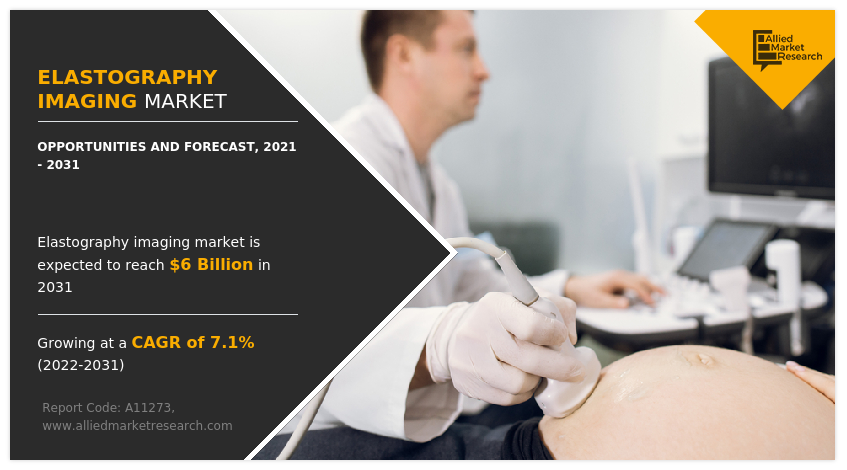
The most widely used techniques utilize ultrasound or magnetic resonance imaging (MRI) to make both the stiffness map and an anatomical image for comparison. Elastography uses low-frequency vibrations during an ultrasound or MRI to determine the stiffness (or elasticity) of organs in-vivo. It is mainly used for detecting the presence and severity of the liver disease. Magnetic resonance elastography (MRE) is a technology that combines MRI imaging with low-frequency vibrations to create a visual map (elastogram) that shows stiffness of body tissues. Currently, MRE is used to detect stiffening of the liver caused by fibrosis and inflammation in chronic liver disease. As patient volumes continue to increase due to aging populations and increasing co-morbidities, and budgets continue to shrink, it’s evident that the elastography imaging market is in a unique position to grow due to its cost-effective, real-time, portable solutions.
The key factors that drive the growth of the elastography imaging market are rise in the prevalence of breast cancer and chronic liver diseases. Moreover, increase in geriatric population, increase in adoption of technologically advanced elastography imaging devices for the diagnosis of disease, and surge in investments in R&D by pharmaceutical companies propel the growth of the market. For instance, in January 2021, Hologic released a new ultrasound scanner, SuperSonic Mach 20, for imaging the breast, liver, muscles, and tendons. The system features B-mode image quality and runs on the company's UltraFast technology, which is part of Hologic's line of SuperSonic ultrasound devices.
Moreover, product advancements and new launches are projected to help the key leaders gain maximum shares, to meet the demand posed by the market, high quality transducer, reduction of diagnosis time, and effective usage in point-of-care and remote diagnosis are the key factors anticipated to fuel the growth of Elastography Imaging Market Size in upcoming years. For instance, Royal Philips, a global leader in health technology, launched new AI-enabled innovations in MR imaging at the Radiological Society of North America (RSNA) annual meeting in November 2021. Philips' new MR portfolio of intelligent integrated solutions is designed to speed up MR exams, streamline workflows, optimize diagnostic quality, and help ensure the efficiency and sustainability of radiology operations.
However, the higher cost of elastography imaging systems is expected to hinder the growth of the industry during the forecast period. Conversely, emerging healthcare markets in developing countries, and low-income countries lacking access to basic healthcare, and alternatively, the use of elastography imaging for cancer research is anticipated to generate new Elastography Imaging Market Opportunity during the forecast time period.
Global Elastography Imaging Market Segmental Overview
The elastography imaging market is segmented on the basis of modality, application, end user, and region. On the basis of modality, the market is divided into ultrasound elastography imaging and magnetic resonance elastography. On the basis of application, the market is classified into radiology/general imaging, obstetrics/gynecology, cardiology, urology, vascular, and others. By end user, the market is categorized into hospitals & clinics, diagnostic labs, maternity centers, ambulatory surgical centers, and others. Region-wise, it is analyzed across North America, Europe, Asia-Pacific, and LAMEA.
By Modality
By modality, the market is segmented into ultrasound elastography imaging and magnetic resonance elastography. In 2021, the ultrasound elastography imaging segment accounted for the largest Elastography Imaging Market Share. The dominance of this segment can be attributed to rise in the prevalence of breast cancer and chronic liver diseases and the increase in the demand of minimally invasive procedures.
The magnetic resonance elastography segment is anticipated to grow at a significant rate during the forecast period. The increase in the adoption of technologically advanced medical devices for diagnostic purposes and the rise in the adoption of magnetic resonance elastography due to its accurate results and painless procedure contribute to the growth of the market.
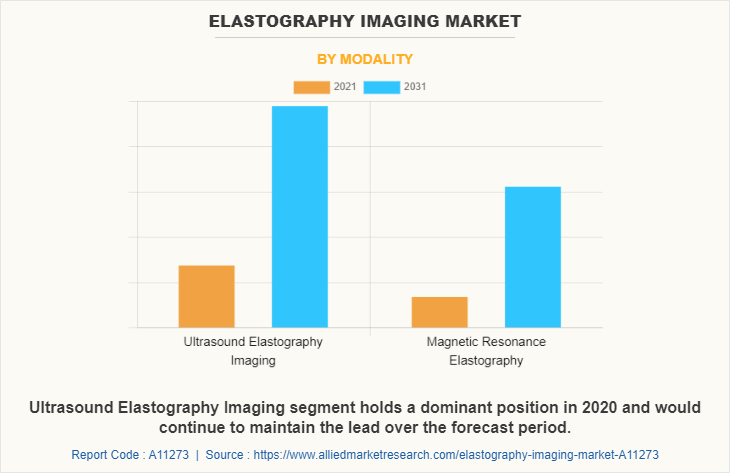
By Application
By application, the elastography imaging market is segmented into radiology/general imaging, obstetrics/gynecology, cardiology, urology, vascular, and others. The radiology/general imaging segment exhibited the highest growth in 2021 and is anticipated to lead during the forecast period, owing to a rise in demand for high-quality diagnostic and therapeutic imaging capabilities as well as a surge in awareness related to radiation dose concerns with other imaging modalities.
The cardiology segment is anticipated to grow at a significant rate during the forecast period. owing to the rise in the prevalence of heart-related diseases leads to the increase in demand for technology advanced elastography imaging for the diagnosis of heart failure, artery diseases, blocked vessels, and other heart-related disorders.
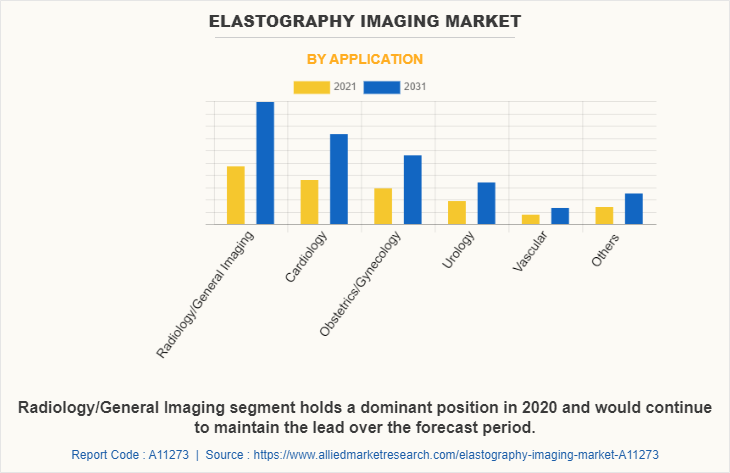
By End User
By end user, the Elastography Imaging Industry is segmented into hospitals and clinics, diagnostic labs, maternity centers, ambulatory surgery centers, and others. The hospitals & clinics segment exhibited the Elastography Imaging Market Share in 2021 and is anticipated to lead during the forecast period, owing to a rise in the number of patient visits in the hospital for the diagnosis of various types of cancer and chronic diseases, and for the purpose of other procedural applications such as gynecologic, obstetric, vascular, and soft tissue screening
The diagnostic labs are expected to witness considerable elastography imaging market growth during the forecast period, owing to the rapid increase in the R&D process, and the installation of technologically advanced medical devices in diagnostic centers.
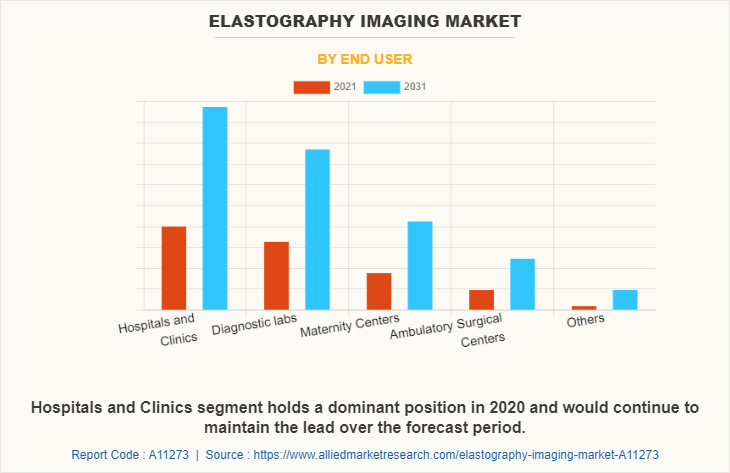
By Region
Region-wise, the elastography imaging market is analyzed across North America, Europe, Asia-Pacific, and LAMEA. North America accounted for a majority of the elastography imaging market share in 2021 and is anticipated to remain dominant during the forecast period. The elastography imaging market is mainly driven by the high adoption of technologically advanced imaging systems, increase in healthcare expenditure and the presence of major key players in the country and the strategies they adopt for their product development.
Asia-Pacific is expected to register the fastest CAGR during the forecast period. The Elastography Imaging Industry growth in the Asia-Pacific region is supplemented by the growing demand for minimally invasive therapies, healthcare reforms, and highly populated countries along with high birth rate and high prevalence of chronic diseases. In addition, the increase in patient awareness and the presence of high unmet needs in these nations, especially in countries such as India and China, are expected to further drive the market growth.
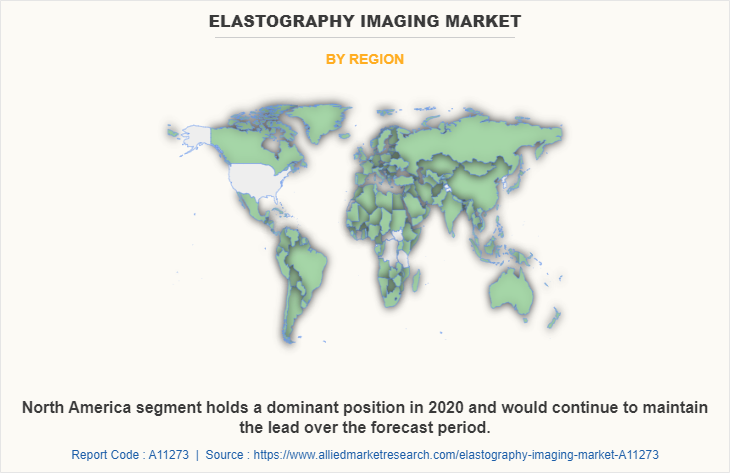
Competition Analysis
The key players that operate in the elastography imaging market are Canon Medical System Corporation, Clarius Mobile Health, Esaote Spa, Fujifim Sonosite Inc, General Electric Company, Hitachi Ltd, Hologic, Koninklijke Philips, Mindray Medical Corporation, Siemens AG.
Key Benefits For Stakeholders
- This report provides a quantitative analysis of the market segments, current trends, estimations, and dynamics of the elastography imaging market analysis from 2021 to 2031 to identify the prevailing elastography imaging market opportunities.
- The market research is offered along with information related to key drivers, restraints, and opportunities.
- Porter's five forces analysis highlights the potency of buyers and suppliers to enable stakeholders make profit-oriented business decisions and strengthen their supplier-buyer network.
- In-depth analysis of the elastography imaging market segmentation assists to determine the prevailing market opportunities.
- Major countries in each region are mapped according to their revenue contribution to the global market.
- Market player positioning facilitates benchmarking and provides a clear understanding of the present position of the market players.
- The report includes the analysis of the regional as well as global elastography imaging market trends, key players, market segments, application areas, and market growth strategies.
Elastography Imaging Market Report Highlights
| Aspects | Details |
| Market Size By 2031 | USD 6 billion |
| Growth Rate | CAGR of 7.1% |
| Forecast period | 2021 - 2031 |
| Report Pages | 341 |
| By End User |
|
| By Modality |
|
| By Application |
|
| By Region |
|
| Key Market Players | Shenzhen Mindray Bio-Medical Electronics Co, Fujifilm Corporation, Hologic Inc, GE, Siemens Healthineers, Hitachi,Ltd, Canon Inc, Koninklijke Philips N.V., Esaote SpA, Clarius Mobile Health |
Analyst Review
This section provides various opinions of top-level CXOs in the elastography imaging market. According to several interviews conducted, the elastography imaging market is expected to witness significant growth in the future, owing to an increase in prevalence of breast cancer and chronic liver diseases, preference for minimally invasive surgeries, and rise of the geriatric population.
According to the perspectives of CXOs, the elastography imaging market is expected to witness steady growth in the future. The rise in geriatric population and various benefits of elastography imaging techniques such as high-quality images, reduction of diagnosis time, and effective usage in point-of-care and remote diagnosis are anticipated to fuel the market growth. The surge in investments in R&D by pharmaceutical companies, rise in healthcare expenditure, and increase in technological advancement are the key factors driving the growth of the market.
However, high cost of elastography imaging systems hampers the growth of the market to some extent during the forecast period. On the contrary, rise in demand for technologically advanced medical devices and a rise in the prevalence of chronic disease and cancer are expected to provide lucrative opportunities for the growth of the elastography imaging market in the future.
In addition, emerging markets are gaining more importance for the majority of the elastography imaging solution manufacturers and distributors. Rapid growth was observed in the shipments of these devices to provide improved healthcare services in emerging nations, and this is expected to offset the challenging conditions in mature markets such as North America and Europe. As per CXOs, North America is expected to dominate the global elastography imaging market during the forecast period followed by Europe.
The upcoming trends are are rise in the prevalence of breast cancer and chronic liver diseases. Moreover, increase in geriatric population, increase in adoption of technologically advanced elastography imaging devices for the diagnosis of disease, and a surge in investments in R&D by pharmaceutical companies propel the growth of the elastography imaging market
The total market value of the Elastography Imaging Market is $3,019.01 million in 2021
North America is the largest regional market for Elastography Imaging
The forecast period in the report is from 2022 to 2031
The market value of the Elastography Imaging Market in 2031 was 6,002.4 Million
The base year for the report is 2021
Yes, Elastography Imaging Market companies are profiled in the report
No, there is a value chain analysis provided in the Elastography Imaging Market report
Loading Table Of Content...



